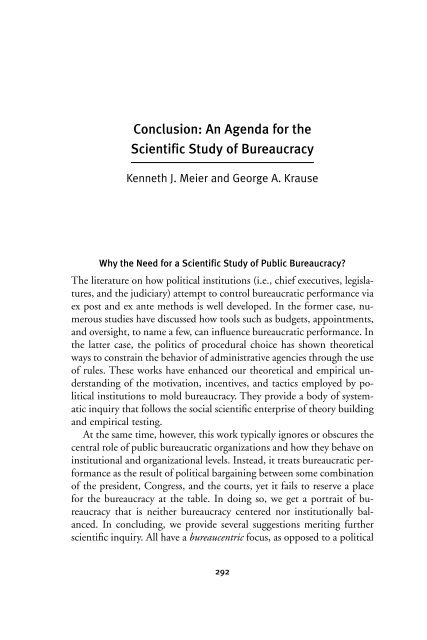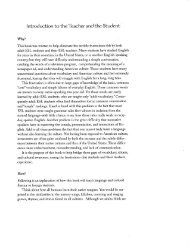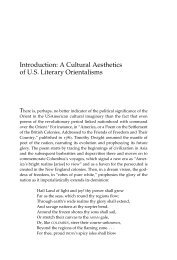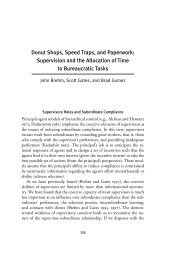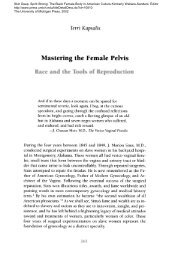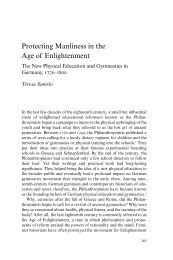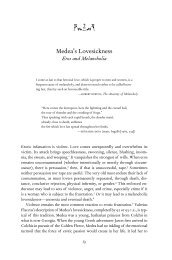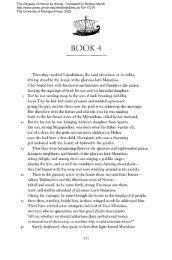Conclusion: An Agenda for the Scientific Study of Bureaucracy
Conclusion: An Agenda for the Scientific Study of Bureaucracy
Conclusion: An Agenda for the Scientific Study of Bureaucracy
You also want an ePaper? Increase the reach of your titles
YUMPU automatically turns print PDFs into web optimized ePapers that Google loves.
<strong>Conclusion</strong>: <strong>An</strong> <strong>Agenda</strong> <strong>for</strong> <strong>the</strong><br />
<strong>Scientific</strong> <strong>Study</strong> <strong>of</strong> <strong>Bureaucracy</strong><br />
Kenneth J. Meier and George A. Krause<br />
Why <strong>the</strong> Need <strong>for</strong> a <strong>Scientific</strong> <strong>Study</strong> <strong>of</strong> Public <strong>Bureaucracy</strong>?<br />
The literature on how political institutions (i.e., chief executives, legislatures,<br />
and <strong>the</strong> judiciary) attempt to control bureaucratic per<strong>for</strong>mance via<br />
ex post and ex ante methods is well developed. In <strong>the</strong> <strong>for</strong>mer case, numerous<br />
studies have discussed how tools such as budgets, appointments,<br />
and oversight, to name a few, can influence bureaucratic per<strong>for</strong>mance. In<br />
<strong>the</strong> latter case, <strong>the</strong> politics <strong>of</strong> procedural choice has shown <strong>the</strong>oretical<br />
ways to constrain <strong>the</strong> behavior <strong>of</strong> administrative agencies through <strong>the</strong> use<br />
<strong>of</strong> rules. These works have enhanced our <strong>the</strong>oretical and empirical understanding<br />
<strong>of</strong> <strong>the</strong> motivation, incentives, and tactics employed by political<br />
institutions to mold bureaucracy. They provide a body <strong>of</strong> systematic<br />
inquiry that follows <strong>the</strong> social scientific enterprise <strong>of</strong> <strong>the</strong>ory building<br />
and empirical testing.<br />
At <strong>the</strong> same time, however, this work typically ignores or obscures <strong>the</strong><br />
central role <strong>of</strong> public bureaucratic organizations and how <strong>the</strong>y behave on<br />
institutional and organizational levels. Instead, it treats bureaucratic per<strong>for</strong>mance<br />
as <strong>the</strong> result <strong>of</strong> political bargaining between some combination<br />
<strong>of</strong> <strong>the</strong> president, Congress, and <strong>the</strong> courts, yet it fails to reserve a place<br />
<strong>for</strong> <strong>the</strong> bureaucracy at <strong>the</strong> table. In doing so, we get a portrait <strong>of</strong> bureaucracy<br />
that is nei<strong>the</strong>r bureaucracy centered nor institutionally balanced.<br />
In concluding, we provide several suggestions meriting fur<strong>the</strong>r<br />
scientific inquiry. All have a bureaucentric focus, as opposed to a political<br />
292
<strong>Conclusion</strong> 293<br />
institutions focus, on understanding how <strong>the</strong> administrative state functions<br />
in a democracy.<br />
<strong>An</strong> <strong>Agenda</strong> <strong>for</strong> <strong>the</strong> <strong>Scientific</strong> <strong>Study</strong> <strong>of</strong> <strong>Bureaucracy</strong><br />
<strong>Bureaucracy</strong> is a growth area in political science. The number <strong>of</strong> scholars<br />
and <strong>the</strong> quality <strong>of</strong> skills is at a level unmatched since at least <strong>the</strong><br />
1940s. Articles on bureaucracy, while by no means prevalent, are no<br />
longer rare. In <strong>the</strong> last two decades, 110 articles with bureaucracy as a<br />
central feature have been published in <strong>the</strong> four leading general political<br />
science journals. 1<br />
Paralleling <strong>the</strong> growth in scholarship is <strong>the</strong> development <strong>of</strong> institutional<br />
apparatuses designed to foster more study <strong>of</strong> public bureaucracy.<br />
The Midwest Public Administration Caucus along with <strong>the</strong> Public Administration<br />
Section <strong>of</strong> <strong>the</strong> American Political Science Association<br />
(APSA), <strong>the</strong> development <strong>of</strong> <strong>the</strong> Journal <strong>of</strong> Public Administration Research<br />
and Theory, and <strong>the</strong> recently established National Public Management<br />
Research Conference data archive and paper posting Web site<br />
() create an infrastructure capable <strong>of</strong><br />
supporting greater intellectual progress in <strong>the</strong> area. The <strong>Scientific</strong> <strong>Study</strong><br />
<strong>of</strong> <strong>Bureaucracy</strong> (S 2 OB) group met <strong>for</strong> <strong>the</strong> first time as part <strong>of</strong> <strong>the</strong> Fifth<br />
National Public Management Conference in College Station, Texas;<br />
those papers became <strong>the</strong> core <strong>of</strong> this volume.<br />
At this stage, taking a broad overview <strong>of</strong> <strong>the</strong> field and becoming more<br />
strategic about developing it seems appropriate. Given our present situation,<br />
where are we likely to make <strong>the</strong> most progress learning more about<br />
bureaucracy? Five areas <strong>of</strong> work are especially promising: getting inside<br />
<strong>the</strong> black box <strong>of</strong> bureaucracy, taking <strong>the</strong>ory more seriously, exploiting <strong>the</strong><br />
variance in bureaucracies, making an explicit return to <strong>the</strong> structural aspects<br />
<strong>of</strong> bureaucracy, and adopting methods that correspond to <strong>the</strong> datagenerating<br />
processes <strong>of</strong> public bureaucracies. The unifying <strong>the</strong>me <strong>for</strong><br />
<strong>the</strong>se five areas is a new organizations approach to studying public bureaucracies.<br />
By new organizations, we mean a study <strong>of</strong> public bureaucracy<br />
focused on administrative organizations, whe<strong>the</strong>r at <strong>the</strong> macro-<br />
(organizational) or microlevel (individual), that generates empirically<br />
testable deductive and nondeductive <strong>the</strong>ories <strong>of</strong> how bureaucratic agencies<br />
function to guide research inquiries. In many ways, this new organizational<br />
approach can be viewed as <strong>the</strong> use <strong>of</strong> rigorous logical, analytical,
294<br />
Politics, Policy, and Organizations<br />
and statistical methods applied to studying <strong>the</strong> timeless issues <strong>of</strong> interest<br />
raised by esteemed scholars <strong>of</strong> public administration such as Max Weber,<br />
Herbert Simon, Lu<strong>the</strong>r Gulick, James March, <strong>An</strong>thony Downs, Francis<br />
Rourke, Herbert Kaufman, and James Q. Wilson.<br />
Inside <strong>the</strong> Black Box<br />
We <strong>of</strong>ten treat bureaucracies as black boxes, mysterious entities that respond<br />
to environmental pressures. In doing so, we learn a great deal<br />
about <strong>the</strong> interaction between bureaucracy and o<strong>the</strong>r political institutions<br />
but learn little about how <strong>the</strong> internal workings <strong>of</strong> <strong>the</strong> bureaucracy<br />
structure <strong>the</strong>se external activities. Probing inside <strong>the</strong> black box has classic<br />
roots. Barnard’s The Functions <strong>of</strong> <strong>the</strong> Executive (1938) was <strong>the</strong> first<br />
modern scholarship to provide insight into superior and subordinate<br />
relationships both within and outside administrative organizations.<br />
Simon’s first major contribution, Administrative Behavior (1947), continued<br />
<strong>the</strong> focus on individual bureaucrats in organizations. His later work<br />
moved to <strong>the</strong> organizational level (Simon, Smithberg, and Thompson<br />
1961) yet retained a behavioral focus that was bureaucentric in nature.<br />
<strong>Bureaucracy</strong> is not <strong>the</strong> only field <strong>of</strong> political science to study a phenomenon<br />
as a black box. Virtually all <strong>of</strong> <strong>the</strong> quantitative work on <strong>the</strong><br />
presidency deals with this institution and some o<strong>the</strong>r institution or<br />
process (e.g., Congress or public opinion) and <strong>the</strong>n studies <strong>the</strong> presidency<br />
in an external fashion. The first priority <strong>of</strong> bureaucracy scholars should be<br />
to understand what bureaucracies do and why <strong>the</strong>y do it. This requires a<br />
bureaucentric focus. To illustrate, if compliance in <strong>the</strong> cases that Brehm<br />
and Gates (1997; Brehm, Gates, and Gomez, this volume) study is so<br />
difficult (i.e., in hierarchical organizations <strong>of</strong> a paramilitary nature with a<br />
great deal <strong>of</strong> pr<strong>of</strong>essionalism), why would we assume that it is so easy in<br />
o<strong>the</strong>r organizations that we study? Fur<strong>the</strong>r <strong>the</strong>oretical and empirical work<br />
within organizations on issues <strong>of</strong> trust, culture, and learning following <strong>the</strong><br />
lead <strong>of</strong> Brehm and Gates (1997) and Miller (1992) should reveal a great<br />
deal about why organizations respond as <strong>the</strong>y do.<br />
A second illustration is presented by Meier and Bohte (1999; Bohte<br />
and Meier 2000), who examine <strong>the</strong> process <strong>of</strong> organizational cheating,<br />
specifically <strong>the</strong> ability <strong>of</strong> school districts to generate higher scores on<br />
standardized tests by exempting from <strong>the</strong> exam <strong>the</strong> students most likely<br />
to fail. The Meier and Bohte studies are only unusual in <strong>the</strong> sophisticated<br />
nature <strong>of</strong> <strong>the</strong> cheating, which involves using institutionalized rules
<strong>Conclusion</strong> 295<br />
and procedures to cloak <strong>the</strong> activity from public <strong>of</strong>ficials. Less sophisticated<br />
cheating characterized <strong>the</strong> Russian bureaucracy, which appeared<br />
to simply make up data when reporting results (Barry and Barner-Barry<br />
1991; Conyngham 1982). Similarly, <strong>the</strong> Philadelphia police department<br />
was recently caught submitting false crime data in order to claim a reduction<br />
in crime and <strong>the</strong> U.S. Air Force’s recent report that high-altitude<br />
bombing destroyed most <strong>of</strong> <strong>the</strong> tanks operating around Kosovo<br />
was later shown to be grossly inaccurate (Barry and Thomas 2000).<br />
Blatant cheating is likely to be infrequent given <strong>the</strong> high costs <strong>of</strong> exposure<br />
(although sufficient cases appear to exist). Cheating is far more<br />
likely and difficult to counteract when it is imbedded in <strong>the</strong> rules and<br />
standard operating procedures <strong>of</strong> <strong>the</strong> organization. Such embedding is<br />
common in educational organizations with <strong>the</strong>ir emphasis on sorting<br />
and classification. The processes <strong>of</strong> <strong>the</strong> organization allow <strong>the</strong>m to<br />
overassign students to special education and limited English classes and<br />
<strong>the</strong>n exclude <strong>the</strong>se students, who are less likely to pass, from state-mandated<br />
tests (Meier and Bohte 1999). In short, cheating permits schools<br />
to manipulate outputs, and thus political principles, by delivering<br />
higher test scores without actually improving per<strong>for</strong>mance on <strong>the</strong> exam.<br />
What looks like political responsiveness may in fact be something entirely<br />
different.<br />
These illustrations suggest a present imbalance in both our <strong>the</strong>oretical<br />
and empirical models <strong>of</strong> bureaucracy. Political actors are viewed as<br />
having multiple tools at <strong>the</strong>ir disposal and also possessing sophisticated<br />
knowledge as to how to organize administrative agencies <strong>for</strong> <strong>the</strong>ir own<br />
advantage. These actors have access to budgets, personnel decisions,<br />
court cases, oversight hearings, and numerous opportunities to signal<br />
<strong>the</strong>ir preferences (e.g., Moe 1982, 1985; Scholz, Twombly and Headrick,<br />
1991; Weingast and Moran 1983; Wood and Waterman 1994). Bureaucracies,<br />
in contrast, are <strong>of</strong>ten treated as naïve and unsophisticated, responding<br />
to politicians in a stimulus-response pattern.<br />
Fur<strong>the</strong>rmore, bureaucratic actors and actions are determined solely by<br />
external, <strong>for</strong>mal political constraints that arise out <strong>of</strong> bargaining between<br />
<strong>the</strong> chief executive and legislature. While such analyses provide an important<br />
segment <strong>of</strong> <strong>the</strong> administrative portrait, <strong>the</strong>y omit <strong>the</strong> role bureaucracies<br />
play as organizations. Such a perspective runs counter to<br />
principal-agent (superior-subordinate) relationships that must be predicated<br />
on a zone <strong>of</strong> acceptable behavior between such parties (Barnard
296<br />
Politics, Policy, and Organizations<br />
1938; Simon 1947) that can be thought <strong>of</strong> as a “two-way street” (Krause<br />
1999). We need models that jointly take into account <strong>the</strong> utility functions<br />
<strong>of</strong> politicians and bureaucratic agencies without relegating <strong>the</strong> latter<br />
to a constraint on <strong>the</strong> optimization problem facing <strong>the</strong> <strong>for</strong>mer. One<br />
excellent example <strong>of</strong> a general equilibrium-type approach is <strong>the</strong> one developed<br />
in Brehm and Gates’s enhanced principal-agent (EPA) model<br />
(1993, 1997).<br />
If parsimony requires simplification, future gains may be greater if we<br />
move in a different direction and assume strategic, multiskilled bureaucracies<br />
and simple, naive politicians <strong>for</strong> counterfactual purposes. The implication<br />
<strong>of</strong> in<strong>for</strong>mation asymmetry is that bureaucrats are more knowledgeable<br />
than politicians on policy matters. This might not be limited to<br />
technical issues and <strong>the</strong> supervision <strong>of</strong> interns; <strong>the</strong>y could be better politicians,<br />
too. Altering <strong>the</strong> assumptions concerning sophistication can provide<br />
a complete range <strong>of</strong> <strong>the</strong>oretical relationships describing <strong>the</strong> interaction<br />
between politicians and bureaucratic agencies. This will help us know<br />
when, why, and under what conditions bureaucracies respond to political<br />
actors. <strong>An</strong>swering <strong>the</strong>se research questions will be easier after scholars get<br />
inside <strong>the</strong> black box <strong>of</strong> bureaucracy to determine how administrative<br />
agencies decide to respond to various environmental stimuli.<br />
One illustration <strong>of</strong> <strong>the</strong> benefits <strong>of</strong> a bureaucracy-centered focus might<br />
be a reconsideration <strong>of</strong> <strong>the</strong> issue <strong>of</strong> ex ante political controls over <strong>the</strong> bureaucracy.<br />
McCubbins, Noll, and Weingast (1987, 1989) and o<strong>the</strong>rs stress<br />
<strong>the</strong> ability <strong>of</strong> Congress to structure <strong>the</strong> organization and its processes and<br />
thus determine its outputs. To be sure, Congress does at times act to<br />
structure a process—<strong>the</strong> well-known cases <strong>of</strong> <strong>the</strong> Consumer Product<br />
Safety Commission (Bryner 1987), with its initial bizarre procedures, and<br />
<strong>the</strong> decision to locate <strong>the</strong> Occupational Safety and Health Administration<br />
(OSHA) in <strong>the</strong> Department <strong>of</strong> Labor ra<strong>the</strong>r than Commerce illustrate<br />
such ex ante controls. For ex ante controls to be effective, however,<br />
Congress would have to engage in such structuring consciously and<br />
we would see evidence <strong>of</strong> systematic applications <strong>of</strong> applied organizational<br />
<strong>the</strong>ory over time by Congress. Hall and O’Toole (2000) investigate<br />
how Congress structured policy programs during two different legislative<br />
sessions. Although <strong>the</strong>ir purpose was to document <strong>the</strong> use <strong>of</strong><br />
networks, <strong>the</strong>y found little evidence that Congress has an organization<br />
<strong>the</strong>ory or that it possesses <strong>the</strong> sophisticated congressional strategy and<br />
understanding <strong>of</strong> organizational relationships necessary to create effec-
<strong>Conclusion</strong> 297<br />
tive procedural (versus substantive) controls over <strong>the</strong> bureaucracy. Additional<br />
empirical evidence lends credence to this view, showing at best<br />
modest support <strong>for</strong> this proposition in diverse policy areas such as<br />
Medicare payments (Balla 1998), state air pollution (Potoski 2000), and<br />
federal hydroelectric licensing programs (Spence 1999b). Research on<br />
hazardous waste implementation reveals that in<strong>for</strong>mal rules are successfully<br />
substituted by an agency in place <strong>of</strong> <strong>for</strong>mal rules when politicians<br />
constrain agency decision making by reducing agency discretion (Hamilton<br />
and Schroeder 1994; Hamilton 1996).<br />
Recent work has demonstrated empirically what students <strong>of</strong> bureaucratic<br />
politics have long believed: relationships between bureaucracy and<br />
political institutions are both dynamic and reciprocal (Krause 1996a,<br />
1999). Bureaucracies by <strong>the</strong>ir actions <strong>of</strong>ten <strong>for</strong>ce political institutions to<br />
respond to <strong>the</strong>m or risk ceding control over a policy area to <strong>the</strong> bureaucracy.<br />
For some relatively complex programs, Congress (e.g., credit control<br />
programs; see Khademian 1995) or <strong>the</strong> president (agricultural policy;<br />
see Meier, Wrinkle, and Polinard 1995) is quite willing to yield control.<br />
In o<strong>the</strong>r cases, Congress and <strong>the</strong> president actively seek to shape <strong>the</strong> actions<br />
<strong>of</strong> <strong>the</strong> bureaucracy. The bottom line, however, is that we should not<br />
assume that <strong>the</strong> casual <strong>for</strong>ce in <strong>the</strong> relationship is <strong>the</strong> political institution.<br />
This is especially true if one views principal-agent relationships requiring<br />
a basic level <strong>of</strong> agreement that comprises a zone <strong>of</strong> acceptable behavior<br />
(Barnard 1938; Simon 1947). While <strong>the</strong> literature on political control over<br />
<strong>the</strong> bureaucracy is well developed, <strong>the</strong> study <strong>of</strong> bureaucratic organizations<br />
is relatively uncharted territory <strong>for</strong> political scientists. Change does<br />
not require eschewing <strong>the</strong> analysis <strong>of</strong> political institutions’ incentives,<br />
tools, and preferences pertaining to policy administration but ra<strong>the</strong>r necessitates<br />
a more serious treatment <strong>of</strong> bureaucratic organizations and<br />
<strong>the</strong>ir features in models <strong>of</strong> bureaucratic politics. Failure to do so can only<br />
result in scholars drawing biased inferences and misleading conclusions<br />
about <strong>the</strong> functioning <strong>of</strong> <strong>the</strong> administrative state.<br />
Taking Theory More Seriously<br />
Principal-agent <strong>the</strong>ory has become <strong>the</strong> predominant paradigm in <strong>the</strong><br />
study <strong>of</strong> bureaucracy over <strong>the</strong> past few decades. Regrettably, our reading<br />
<strong>of</strong> <strong>the</strong> literature leads us to conclude that political science scholarship has<br />
<strong>of</strong>ten, though clearly not always, failed to appropriately apply principalagent<br />
<strong>the</strong>ory in empirical studies. 2 Principal-agent models <strong>of</strong> political
298<br />
Politics, Policy, and Organizations<br />
control over <strong>the</strong> bureaucracy must allow <strong>for</strong> both a strategic principal and<br />
a strategic agent, with each able to behave in a proactive manner in a relationship<br />
with inherent goal conflict (Mitnick 1980; Perrow 1986; Ross<br />
1973). Principal-agent <strong>the</strong>ory requires a dynamic, inherently changing set<br />
<strong>of</strong> relationships over time. Perhaps such relationships come to an equilibrium,<br />
perhaps not. In <strong>the</strong> prime area <strong>of</strong> principal-agent <strong>the</strong>ory, that is,<br />
where it originated (e.g., doctor-patient relationship), with voluntary relationships<br />
characterized by goal conflict and in<strong>for</strong>mation asymmetry,<br />
many relationships do not evolve to an equilibrium. A large number <strong>of</strong><br />
relationships between doctors and patients, customers and insurance<br />
agents, and homeowners and service personnel are simply terminated.<br />
Theories must consider this fact on two dimensions. First, Lewis’s study<br />
on agency termination in <strong>the</strong> postwar era (2000b) finds that 62 percent<br />
<strong>of</strong> agencies created since 1946 have been terminated. This impermanence<br />
and <strong>the</strong> nonvoluntary nature <strong>of</strong> <strong>the</strong> relationship suggests that <strong>the</strong> model<br />
must be fundamentally changed if it is to be useful. Second, termination<br />
is sometimes not feasible because <strong>the</strong> bureaucracy is a monopoly provider<br />
(e.g., national defense) or <strong>the</strong> transaction costs <strong>of</strong> termination are massive<br />
(e.g., abolishing <strong>the</strong> Department <strong>of</strong> Education). Such relationships in realistic<br />
terms become mandatory, not voluntary. Both problems illustrate<br />
<strong>the</strong> need <strong>for</strong> <strong>the</strong>oretical development that incorporates <strong>the</strong>se institutional<br />
aspects <strong>of</strong> bureaucracy.<br />
Examining <strong>the</strong> empirical studies reveals few analyses claiming to use<br />
agency <strong>the</strong>ory that actually take advantage <strong>of</strong> <strong>the</strong> driving features <strong>of</strong> principal-agent<br />
models—goal conflict and in<strong>for</strong>mation asymmetry (see Waterman<br />
and Meier 1998). Principal-agent models assume conflict between<br />
<strong>the</strong> goals <strong>of</strong> <strong>the</strong> principal and <strong>the</strong> agent (Ross 1973). While this may be<br />
true <strong>for</strong> many agencies responsible <strong>for</strong> implementing regulatory policies,<br />
it is a questionable assumption in instances in which politicians and administrative<br />
agencies do not have inherently conflicting goals. For instance,<br />
distributive policies that yield positive-sum gains <strong>for</strong> clientele<br />
groups, congressional committees, and bureaucratic agencies (Ripley and<br />
Franklin 1984) do not fit <strong>the</strong> depiction <strong>of</strong> <strong>the</strong> principal-agent model as it<br />
was originally developed in law and financial economics. In <strong>the</strong>se areas,<br />
agencies and legislatures will share goals. <strong>An</strong> appropriate empirical illustration<br />
<strong>of</strong> this symbiotic agency-political relationship can be found in <strong>the</strong><br />
U.S. Department <strong>of</strong> Agriculture’s (USDA’s) farm credit programs (Meier,<br />
Polinard, and Wrinkle 1999). The conventional principal-agent hypo<strong>the</strong>-
<strong>Conclusion</strong> 299<br />
sis, that politicians will attempt to control <strong>the</strong> bureaucracy through monitoring<br />
and incentives, is misguided in <strong>the</strong>se types <strong>of</strong> agency-political relationships.<br />
The moral hazard problem endemic in conventional models<br />
is not a serious issue when bureaucracies (subordinates) acting in <strong>the</strong>ir<br />
own best interests take actions consistent with <strong>the</strong> goals <strong>of</strong> political institutions<br />
(superiors; see Brehm and Gates 1997).<br />
In o<strong>the</strong>r ways, our empirical knowledge has far outdistanced this simply<br />
<strong>the</strong>ory. As an illustration, Khademian (1995) examined what she<br />
called bottom-line agencies, those characterized by goal consensus and<br />
substantial in<strong>for</strong>mation asymmetry. Her conclusion was that infrequent<br />
but goal-oriented legislation is <strong>the</strong> primary method <strong>of</strong> control. Procedural<br />
controls will not be considered. Meier, Polinard, and Wrinkle<br />
(1999), examining agricultural debt, corroborated Khademian’s finding<br />
and demonstrated that o<strong>the</strong>r traditional principal-agent variables had<br />
little impact. A second, related hypo<strong>the</strong>sis from <strong>the</strong> literature is that political<br />
control is enhanced by, but needed less, when clear, precise statutes<br />
are <strong>the</strong> responsibility <strong>of</strong> a single agency with sufficient resources (Mazmanian<br />
and Sabatier 1989). While this pattern rarely occurs, statutory<br />
coherence can be measured, and some evidence suggests that coherence<br />
matters (Meier and McFarlane 1996).<br />
Developing <strong>the</strong>ory in this area involves determining which types <strong>of</strong><br />
bureaucracies respond, and in what ways, to political pressure. From <strong>the</strong><br />
bureaucratic politics literature, we already know that agencies with support<br />
from clientele groups are less likely to respond to demands from political<br />
<strong>of</strong>ficials (Rourke 1984; Rubin 1985). Meier (1997) speculated that<br />
democratic constitutional legitimacy matters; if one defines <strong>the</strong> legitimacy<br />
<strong>of</strong> political pressure with legislation at one pole and ex parte contact<br />
on an adjudication at <strong>the</strong> o<strong>the</strong>r, as one moves toward <strong>the</strong> legislative<br />
pole bureaucracies are more responsive to political demands.<br />
These tidbits <strong>of</strong> political control could be integrated <strong>the</strong>oretically.<br />
Such a <strong>the</strong>ory would recognize that institutional characteristics generate<br />
certain types <strong>of</strong> interactions with o<strong>the</strong>r institutions. The real breakthrough<br />
in institutional <strong>the</strong>ory will go to <strong>the</strong> first person who links <strong>the</strong><br />
structural characteristics <strong>of</strong> both political and administrative institutions<br />
to <strong>the</strong> ways in which <strong>the</strong>y interact with one ano<strong>the</strong>r.<br />
Miller (2000) presents ano<strong>the</strong>r challenge to <strong>the</strong> principal-agent<br />
model. Using <strong>the</strong>oretical work developed <strong>for</strong> private sector organizations,<br />
he argues that principal-agent models will not produce benefits
300<br />
Politics, Policy, and Organizations<br />
consistent with <strong>the</strong> goals <strong>of</strong> principals. Private sector organizations have<br />
solved <strong>the</strong> moral hazard and adverse selection problems by divorcing<br />
ownership (principals) from management (agents) and consciously recruiting<br />
managers with goals different from ownership. In <strong>the</strong>se models,<br />
goal conflict is a positive good and should not be minimized. Contemporary<br />
principal-agent <strong>the</strong>ory, according to Miller, provides <strong>the</strong> wrong<br />
guidance in policy design.<br />
In addition to macro<strong>the</strong>ories <strong>of</strong> bureaucracy and its interaction with<br />
political institutions, more middle range <strong>the</strong>ories <strong>of</strong> bureaucratic decision<br />
making are also needed. This book provides two illustrations. Daniel P.<br />
Carpenter, in his chapter, argues that voting <strong>the</strong>ories are inappropriate because<br />
bureaucratic decisions are essentially decisions to stop a process. His<br />
stopping processes models can be applied to a wide variety <strong>of</strong> bureaucratic<br />
decisions in which <strong>the</strong> choice is between action and inaction (Food and<br />
Drug Administration drug approvals, issuing rules by regulatory agencies,<br />
citing a violation <strong>of</strong> law, granting a license, etc.). One interesting future<br />
<strong>the</strong>oretical question is how stopping processes are altered when political<br />
principals impose a time limit on <strong>the</strong> processes. Using bureaucratic organizations<br />
as <strong>the</strong> decision unit <strong>of</strong> analysis, George A. Krause examines<br />
agency risk taking in terms <strong>of</strong> how much discretion agencies wish to obtain<br />
in relation to <strong>the</strong> policy outcome uncertainty that <strong>the</strong>y confront. This<br />
allows deriving empirically testable conditions <strong>of</strong> risk-averse, risk-neutral,<br />
and risk-seeking bureaucratic behavior.<br />
Normative <strong>the</strong>ory with regard to bureaucracy has generally been ignored<br />
by political scientists, even though <strong>the</strong>ories such as budget maximization<br />
have normative implications. David B. Spence in this volume<br />
uses rational choice logic to argue that in some cases citizens will prefer<br />
decisions made by bureaucrats ra<strong>the</strong>r than by elected <strong>of</strong>ficials. The degree<br />
to which expertise tempers representation processes is <strong>the</strong> key factor<br />
in this decision <strong>for</strong> citizens. Spence’s work is a blueprint <strong>for</strong> those interested<br />
in designing public policy to be responsive to a set <strong>of</strong> values, be<br />
<strong>the</strong>y citizen preferences, overall efficiency, or some o<strong>the</strong>r value.<br />
Just as all principal-agent <strong>the</strong>orists assume that <strong>the</strong> principal’s values<br />
should be controlling, an extensive literature in bureaucratic politics supports<br />
democratic control over bureaucracy (see Rourke 1984). At <strong>the</strong><br />
same time, because <strong>the</strong> process <strong>of</strong> establishing democratic values through<br />
overhead democracy is not especially efficient (i.e., <strong>the</strong>re is a great deal <strong>of</strong><br />
slippage between <strong>the</strong> electorate and representatives) and because indi-
<strong>Conclusion</strong> 301<br />
vidual bureaucrats are also citizens and may hold appropriate values,<br />
trade-<strong>of</strong>fs between democracy and bureaucracy are possible. A normative<br />
<strong>the</strong>ory that started from <strong>the</strong> premise that democratic values, while important,<br />
should not always be controlling (e.g., Meier 1997) would argue<br />
<strong>for</strong> different institutional relationships than would <strong>the</strong> conventional<br />
principal-agent model <strong>of</strong> political control over <strong>the</strong> bureaucracy with its<br />
key simplifying assumption <strong>of</strong> principal supremacy.<br />
Exploiting <strong>the</strong> Variance in Bureaucracies<br />
<strong>Bureaucracy</strong> scholars overstudy federal regulatory agencies. Early quantitative<br />
studies <strong>of</strong> bureaucracy (Moe 1982; Weingast and Moran 1983; Wood<br />
1988) examined regulatory agencies, and <strong>the</strong>ir example provided a template<br />
<strong>for</strong> subsequent studies. Federal regulatory agencies, however, have<br />
characteristics distinctly different from those <strong>of</strong> o<strong>the</strong>r bureaucracies, especially<br />
in terms <strong>of</strong> variables related to political control. This overfocus on<br />
regulation calls into question how general <strong>the</strong> findings in <strong>the</strong> literature are.<br />
At least two solutions to this problem exist. First, most bureaucracies are<br />
local. If scholars want a situation in which one can turn some <strong>of</strong> our variables<br />
into constants and get good comparability across agencies, <strong>the</strong>n <strong>the</strong><br />
best strategy is to select <strong>the</strong> same type <strong>of</strong> agencies across states or local jurisdictions<br />
(Gordon 2000; Ingraham and Kneedler 1999; Schneider and Jacoby<br />
1996). The most common bureaucracies in both number and employment<br />
are schools, yet only recently have schools been used to examine<br />
questions <strong>of</strong> bureaucracy (e.g., Abernathy 2000; Chubb and Moe 1990).<br />
Using state or local agencies sometimes increases <strong>the</strong> difficulty <strong>of</strong> ga<strong>the</strong>ring<br />
data since <strong>the</strong> analyst must contact more than one agency with a survey or<br />
a Freedom <strong>of</strong> In<strong>for</strong>mation Act request, but <strong>the</strong> large number <strong>of</strong> such<br />
agencies means that <strong>the</strong> response rate does not have to be perfect. A crosssectional<br />
analysis <strong>of</strong> this sort could also be done cross-nationally, although<br />
data-ga<strong>the</strong>ring problems would increase significantly. A <strong>the</strong>oretical ef<strong>for</strong>t<br />
to do this by Thomas H. Hammond, included in this volume, considers<br />
how alternative institutional arrangements produce different types <strong>of</strong> policy<br />
outcomes. Recent cross-national research on <strong>the</strong> topic <strong>of</strong> political<br />
delegation to <strong>the</strong> bureaucracy by Huber (2000) and Huber and Shipan<br />
(2002, 2000) has begun to make vital <strong>the</strong>oretical and empirical strides in<br />
addressing this issue from an electoral institutions perspective in a manner<br />
that builds on American work by Epstein and O’Halloran (1999).<br />
What remains unear<strong>the</strong>d altoge<strong>the</strong>r, however, is a concerted <strong>the</strong>oretical
302<br />
Politics, Policy, and Organizations<br />
and empirical focus on how public bureaucracies function in a variable<br />
manner cross-nationally from an organizational perspective.<br />
Second, we could easily focus on nonregulatory agencies at <strong>the</strong> federal<br />
level. Social service agencies, as ano<strong>the</strong>r illustration, are differently structured,<br />
with different traditions and standard operating procedures (see<br />
Goodsell 1983). Similar arguments could be made <strong>for</strong> redistributive agencies,<br />
pork barrel agencies, government corporations, and advisory organizations.<br />
If Lowi’s (1964) typology <strong>of</strong> policies is not useful, <strong>the</strong>n perhaps<br />
Wilson’s (1989) typology <strong>of</strong> government organizations will be. Recent<br />
movements into nonregulatory agencies such as health care (Balla 1998),<br />
social welfare (Keiser and Soss 1998), and agriculture (Meier, Wrinkle,<br />
and Polinard 1995) are long overdue. Keiser, in this volume, continues<br />
her work on social welfare agencies; Smith (this volume) examines bureaucratic<br />
values in educational organizations, and Corder (this volume),<br />
uses federal credit policies.<br />
Future studies <strong>of</strong> bureaucracy need to continue <strong>the</strong>se nascent ef<strong>for</strong>ts<br />
to expand <strong>the</strong> range <strong>of</strong> bureaucracies studied. <strong>Bureaucracy</strong> takes many<br />
<strong>for</strong>ms—nonpr<strong>of</strong>its, networks, government corporations—and engages<br />
in a wide variety <strong>of</strong> different relationships with political institutions.<br />
Only by increasing <strong>the</strong> variation in <strong>the</strong> types <strong>of</strong> bureaucracy that are<br />
studied can we hope to provide general findings about how <strong>the</strong> bureaucracy<br />
functions within a representative democracy.<br />
Explicit Incorporation <strong>of</strong> Structure<br />
As scholars, we have a great deal to contribute by relying on our strength,<br />
<strong>the</strong> understanding <strong>of</strong> how structures affect behavior. Two types <strong>of</strong> structures<br />
are relevant. First, standard operating procedures both within and<br />
external to <strong>the</strong> agencies are important. Agriculture agencies, <strong>for</strong> example,<br />
interact with Congress in ways different from, say, <strong>the</strong> Environmental<br />
Protection Agency. Health research agencies have different interactions<br />
with appropriations committees than <strong>the</strong> Equal Employment Opportunities<br />
Commission (EEOC) does. A brief reading <strong>of</strong> congressional hearings<br />
can document <strong>the</strong>se differences. Some <strong>of</strong> <strong>the</strong>se differences in interactions<br />
might be a function <strong>of</strong> mission or it might be something else, but<br />
relationships are structured differently across agencies, and this affects<br />
policy decisions.<br />
Second, organizational structures need to be incorporated in our work.<br />
Structural questions once were central to <strong>the</strong> study <strong>of</strong> bureaucracy. The
<strong>Conclusion</strong> 303<br />
work <strong>of</strong> Meier and Bohte reintroduces <strong>the</strong> concept <strong>of</strong> span <strong>of</strong> control to<br />
<strong>the</strong> study <strong>of</strong> bureaucracy. Meier and Bohte (2000a) derived some <strong>the</strong>oretical<br />
expectations and <strong>the</strong>n examined <strong>the</strong> impact <strong>of</strong> span <strong>of</strong> control on<br />
agency outputs in educational organizations. A second essay (2000b)<br />
claims that wider spans <strong>of</strong> control provide greater discretion to street-level<br />
bureaucrats; <strong>the</strong>y <strong>the</strong>n test this by using <strong>the</strong> logic <strong>of</strong> representative bureaucracy,<br />
finding that minority teachers have more impact in decentralized<br />
systems.<br />
Numerous o<strong>the</strong>r internal structures affect organizational per<strong>for</strong>mance.<br />
Decentralization is a concept that is sometimes addressed by examining<br />
local units or regions <strong>of</strong> federal bureaucracies; it is a concept that needs to<br />
be brought to <strong>the</strong> <strong>for</strong>efront. Decentralized organizations are dominated<br />
by street-level bureaucrats; attempts to generalize <strong>the</strong> models <strong>of</strong> Brehm,<br />
Gates, and Gomez to o<strong>the</strong>r such organizations are likely to have some<br />
positive results. Recruitment processes and structures within administrative<br />
agencies also clearly matter (Carpenter 2001). The reliance <strong>of</strong> <strong>the</strong><br />
USDA on state land grant schools, OSHA’s initial preference <strong>for</strong> industrial<br />
hygienists and safety engineers, and <strong>the</strong> 1960s Federal Trade Commission<br />
recruitment from second-rate sou<strong>the</strong>rn law schools all affected<br />
<strong>the</strong> development <strong>of</strong> <strong>the</strong>se organizations.<br />
From <strong>the</strong> public administration literature, <strong>the</strong> concept <strong>of</strong> networks is<br />
also relevant (Milward and Provan 1998; O’Toole 1997). Policy, in many<br />
areas, is no longer implemented by means <strong>of</strong> a single organization but<br />
by a network <strong>of</strong> organizations that <strong>of</strong>ten operate across levels <strong>of</strong> government.<br />
The lack <strong>of</strong> hierarchical control in networks implies that different<br />
leadership styles are needed <strong>for</strong> effective policy implementation.<br />
Theoretical work on networks from sociology can be useful in trying to<br />
get a handle on interorganizational networks (e.g., Skvoretz and Fararo<br />
1996; Skvoretz and Willer 1993). For instance, does evidence <strong>of</strong> strong<br />
or weak ties (Granovetter 1973) affect patterns <strong>of</strong> relationships between<br />
superiors and subordinates within an administrative organization,<br />
among bureaucratic organizations, and among politicians and agencies?<br />
This question has critical implications <strong>for</strong> key concepts such as control,<br />
accountability, and effectiveness. Scholarship on policy networks that<br />
focuses on national policy subsystems may be instructive <strong>for</strong> analyzing<br />
how bureaucratic agencies interact with one ano<strong>the</strong>r as well as with <strong>the</strong><br />
larger political environment (Carpenter, Esterling, and Lazer 1998; Laumann<br />
and Knoke 1987; Heinz, et al. 1993).
304<br />
Politics, Policy, and Organizations<br />
Structure is not just an internal variable; it can also be used to sharpen<br />
o<strong>the</strong>r analyses. Mintzberg’s (1983) examination <strong>of</strong> organizational structures<br />
argues <strong>for</strong> various methods <strong>of</strong> control within an organization, including<br />
oversight, socialization <strong>of</strong> values, standardizing training, and<br />
routinization <strong>of</strong> procedures. His work is intended to operate within an<br />
organization but with little ef<strong>for</strong>t could be trans<strong>for</strong>med into an approach<br />
to presidential control over <strong>the</strong> bureaucracy. Presidential tools such as reporting<br />
(oversight), socialization <strong>of</strong> values (orientating political appointees<br />
to presidential priorities), recruiting individuals with given values<br />
(those who share values with <strong>the</strong> president), and so on are similar to<br />
Mintzberg’s internal organizational structures. Mintzberg’s <strong>the</strong>ory could<br />
both integrate <strong>the</strong> methods <strong>of</strong> presidential control and suggest when one<br />
set <strong>of</strong> controls is more likely to be used.<br />
A few hypo<strong>the</strong>ses about how internal structure might affect external relationships<br />
also come to mind. Overhead controls will work less well in<br />
highly decentralized organizations with strong value socialization like <strong>the</strong><br />
Forest Service. Agencies that have regional <strong>of</strong>fices but do not rotate <strong>the</strong>ir<br />
personnel from region to region will develop a heterogeneous set <strong>of</strong> values<br />
that will be difficult to direct centrally. In terms <strong>of</strong> <strong>for</strong>mal structures,<br />
O’Toole’s (1997) work on networks suggests that <strong>the</strong>y are far more difficult<br />
to control than hierarchies. Relatedly, Milward and Provan’s (1998)<br />
empirical analysis <strong>of</strong> mental health networks in four cities finds that <strong>the</strong><br />
most effective network was controlled by a monopoly provider that dominated<br />
both service provision and <strong>the</strong> terms under which mental health<br />
services and funding were provided by o<strong>the</strong>r agencies. Taken toge<strong>the</strong>r, this<br />
suggests that networks have considerable difficulty in undertaking concerted<br />
action unless authority can be consolidated and exercised in a unified<br />
manner.<br />
Considerable merit exists <strong>for</strong> <strong>the</strong> <strong>the</strong>sis that bureaucratic structure is<br />
important in understanding how administrative agencies operate and<br />
that it is inherently political in nature (Moe 1989, 1990; see also Knott<br />
and Miller 1987). Recent research by Lewis (2000a) has shown that some<br />
administrative agencies are structured in a manner that makes <strong>the</strong>m<br />
more susceptible to political influence than o<strong>the</strong>rs (see also Wood and<br />
<strong>An</strong>derson 1992). <strong>An</strong>alysis <strong>of</strong> bureaucratic structures can also help us to<br />
understand how bureaucratic decisions and outcomes disseminate<br />
through <strong>the</strong> regional field <strong>of</strong>fices found in many federal bureaucracies<br />
(Gordon 2000; Schmidt 1995; Whit<strong>for</strong>d 1998). Finally, <strong>the</strong> structure <strong>of</strong>
<strong>Conclusion</strong> 305<br />
bureaucratic organizations also matters in assessing how different types<br />
<strong>of</strong> bureaucratic agents, who are appointed in a differential manner, respond<br />
to <strong>the</strong> “contractual” versus “noncontractual” principals that <strong>the</strong>y<br />
must encounter (Krause 1994, 1996b).<br />
Methods<br />
The scientific study <strong>of</strong> bureaucracy needs to adopt methods that correspond<br />
to <strong>the</strong> data-generating process in bureaucracies. Gill and Meier<br />
(2000) make a series <strong>of</strong> general points about methods and <strong>the</strong>ir fit with<br />
<strong>the</strong> types <strong>of</strong> problems that are relevant to <strong>the</strong> studies in this book. The<br />
correspondence between Bayesian methods and how bureaucracies actually<br />
make decisions is self-evident. The essay also suggests greater use <strong>of</strong><br />
qualitative methods that can reflect values (substantively weighted analytical<br />
technique, SWAT), methods that incorporate <strong>the</strong> autoregressive<br />
nature <strong>of</strong> bureaucracies (time-series), and a skepticism <strong>of</strong> traditional hypo<strong>the</strong>sis<br />
testing. In this volume, two <strong>of</strong> <strong>the</strong> essays’ main contribution is<br />
to push <strong>the</strong> methodological boundaries <strong>of</strong> inquiry in <strong>the</strong> study <strong>of</strong> public<br />
bureaucracy. Brehm, Gates, and Gomez introduce both new graphical<br />
and statistical modeling approaches, using compositional data analytic<br />
techniques to analyze workers’ choices. Whit<strong>for</strong>d’s analysis <strong>of</strong> agency<br />
competition, punishment, and imitation applies computational (or computer<br />
simulation) methods to analyzing bureaucratic organizations. In<br />
addition, recent research has placed considerable emphasis on <strong>the</strong> timing<br />
<strong>of</strong> bureaucratic decisions (Carpenter 2000b; Whit<strong>for</strong>d 1998) and life expectancies<br />
<strong>for</strong> administrative agencies (initially raised in Downs 1967 and<br />
Kaufman 1976) using event history and duration statistical modeling<br />
techniques (Carpenter 1999; Lewis 2000b).<br />
O<strong>the</strong>r examples <strong>of</strong> adjusting methods to problems could be found. A<br />
historical example is <strong>the</strong> way courts and administrative agencies have<br />
learned to deal with each o<strong>the</strong>r over time. In 1965, Kenneth Culp Davis<br />
contended that agencies generally ignored courts, but by 1996 Spriggs<br />
(1996) found agencies very responsive to court decisions. The responsiveness<br />
<strong>of</strong> agencies to courts <strong>of</strong> law varies by agency, but clearly some equilibrium<br />
has been reached on <strong>the</strong> scope <strong>of</strong> court oversight and <strong>the</strong> degree<br />
<strong>of</strong> responsiveness by agencies. The conclusion that <strong>the</strong> relationships between<br />
bureaucracy and o<strong>the</strong>r institutions will be in long-run equilibrium<br />
implies that <strong>the</strong>se relationships should be examined via <strong>the</strong> methods <strong>of</strong><br />
cointegration. Similarly, Moe’s (1985) argument about <strong>the</strong> National Labor
306<br />
Politics, Policy, and Organizations<br />
Relations Board, whereby labor and management adjust <strong>the</strong>ir expectations<br />
to <strong>the</strong> ideology <strong>of</strong> <strong>the</strong> board, could also be analyzed in this manner<br />
with a long enough time-series.<br />
<strong>Conclusion</strong><br />
This volume provides a series <strong>of</strong> essays that examine public bureaucracy<br />
from a bureaucentric perspective. The work has much in common with<br />
<strong>the</strong> “new institutionalism” <strong>of</strong> <strong>the</strong> past two decades in terms <strong>of</strong> an emphasis<br />
on systematic inquiry containing logical and/or empirical rigor<br />
and <strong>the</strong> attempt to understand how <strong>the</strong> administrative state functions in<br />
a democracy. This “new organizations” approach, however, departs from<br />
new institutionalism with respect to investigating public bureaucracies.<br />
The <strong>for</strong>mer view maintains that <strong>the</strong> key to understanding <strong>the</strong> administrative<br />
state is not to focus solely on democratic institutions such as <strong>the</strong><br />
president, Congress, and <strong>the</strong> courts in order to explain bureaucratic behavior<br />
and decision making, as displayed in new institutionalism scholarship,<br />
but to also focus on a thorough analysis <strong>of</strong> bureaucratic agencies<br />
as institutions <strong>of</strong> governance that contain <strong>the</strong>ir own unique incentives,<br />
procedures, and preferences <strong>for</strong> administering public policy. Although<br />
administrative agencies can be notably affected by rules and procedures<br />
designed by legislatures to control <strong>the</strong> <strong>for</strong>mer’s behavior; <strong>the</strong>y do not sit<br />
on <strong>the</strong> sidelines as spectators when chief executives and legislatures bargain<br />
and maneuver over <strong>the</strong>ir fate (Carpenter 2000; Hammond and<br />
Knott 1996; Wilson 1989). The point that administrative agencies play a<br />
vital role in shaping how policy is administered cannot be overlooked in<br />
<strong>the</strong> study <strong>of</strong> <strong>the</strong> politics <strong>of</strong> <strong>the</strong> administrative state.<br />
We concur with a sentiment expressed by Moe (1984, 758) nearly two<br />
decades ago when discussing <strong>the</strong> new economics <strong>of</strong> organization and its<br />
subsequent application to <strong>the</strong> study <strong>of</strong> public bureaucracies within political<br />
science.<br />
In all likelihood, <strong>the</strong> contractual paradigm will continue to dominate<br />
economic approaches to organization, owing to its linkages to<br />
neoclassicism. But it will also continue to include diverse approaches,<br />
some far more concerned than o<strong>the</strong>rs with <strong>the</strong> empirical<br />
richness. The principal-agent model, ideally suited to <strong>the</strong> analysis<br />
<strong>of</strong> hierarchical relationships, is understandably <strong>the</strong> major means <strong>of</strong><br />
<strong>for</strong>mal modeling at present and should become well-established as<br />
an important tool <strong>for</strong> organizational analysis. Given <strong>the</strong> counter-
<strong>Conclusion</strong> 307<br />
vailing influences, however, and given <strong>the</strong> broader tasks <strong>of</strong> organization<br />
<strong>the</strong>ory, <strong>the</strong> current fervor surrounding <strong>the</strong> principal-agent<br />
model will likely give way to a more eclectic methodology within<br />
which that model plays a less pronounced but integral role.<br />
Clearly, <strong>the</strong> application and utility <strong>of</strong> principal-agent and o<strong>the</strong>r contractually<br />
based paradigms as important <strong>the</strong>oretical devices in understanding<br />
bureaucratic per<strong>for</strong>mance within political science have been demonstrated.<br />
At <strong>the</strong> same time, however, <strong>the</strong>se approaches suffer from inherent<br />
limitations that prevent us from acquiring an adequate understanding <strong>of</strong><br />
many vital issues that we need to address as social scientists concerned<br />
with <strong>the</strong>ory building and empirical testing <strong>of</strong> hypo<strong>the</strong>ses centered on how<br />
public bureaucracies function within a democratic system <strong>of</strong> governance.<br />
We believe <strong>the</strong> time has come <strong>for</strong> more eclectic approaches in scientifically<br />
analyzing public bureaucracy in democratic settings.<br />
The essays contained in this volume attempt to enhance our <strong>the</strong>oretical<br />
and empirical understanding <strong>of</strong> how bureaucracies operate as distinct<br />
organizations as well as in relation to <strong>the</strong> larger political environment.<br />
These works seek a better understanding <strong>of</strong> how bureaucratic organizations<br />
per<strong>for</strong>m by placing primary emphasis on analyzing <strong>the</strong>se entities as<br />
opposed to relying on o<strong>the</strong>r democratic institutions <strong>for</strong> answers regarding<br />
administrative behavior. Our goal is that future scholarship on public bureaucracy<br />
within political science will not eschew <strong>the</strong> importance <strong>of</strong> administrative<br />
organizations when developing <strong>the</strong>ories and empirical tests<br />
concerning <strong>the</strong> functioning <strong>of</strong> <strong>the</strong> administrative state.<br />
Notes<br />
1. These four journals are <strong>the</strong> American Political Science Review, American<br />
Journal <strong>of</strong> Political Science, Journal <strong>of</strong> Politics, and British Journal <strong>of</strong> Political Science,<br />
covering <strong>the</strong> 1981–2000 period.<br />
2. Our basic <strong>the</strong>oretical understanding <strong>of</strong> <strong>the</strong> principal-agent model is well<br />
developed in some instances (e.g., see Bendor, Taylor, and Van Gaalen 1985;<br />
Perrow 1986; Mitnick 1980; and Moe 1984). The applied <strong>the</strong>oretical work tends<br />
to address relatively small, specific problems (e.g., budget maximizing) in<br />
order to make <strong>the</strong> problem tractable. This permits <strong>the</strong>se applied <strong>the</strong>orists to<br />
deal with a relatively sophisticated bureaucracy on <strong>the</strong> strategy side if not on<br />
<strong>the</strong> goals side.


